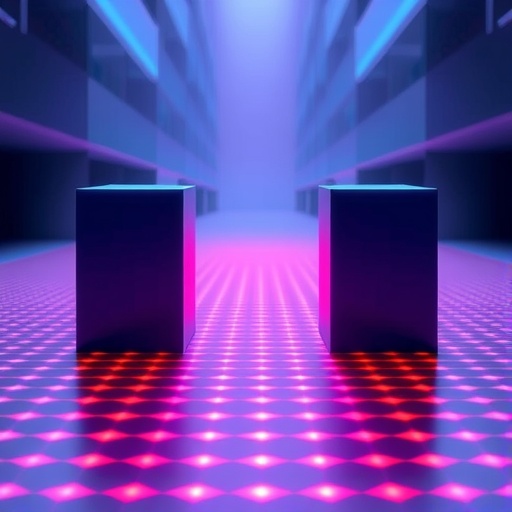In a groundbreaking advancement poised to redefine the landscape of wavefront engineering, a team of leading scientists has unveiled a novel theoretical framework that fundamentally reshapes our understanding of gradient metasurfaces’ interaction with electromagnetic waves. Published recently in the prestigious journal Light: Science & Applications, this research introduces the Spatial Harmonic-expanded Generalized Snell’s Law (SH-GSL), a paradigm-shifting theory that addresses long-standing gaps in the manipulation of higher-order spatial harmonics within metasurface designs.
Since the inception of the Generalized Snell’s Law (GSL), planar metasurfaces have played a transformative role in directing and controlling optical and electromagnetic wavefronts through engineered phase gradients. These metasurfaces have demonstrated exciting capabilities, including beam steering, focusing, and holography, primarily by modulating the fundamental wave components of reflected or transmitted waves. Yet, despite these advances, their functionality has been confined largely to “single-channel” devices due to a critical oversight: the role of higher-order spatial harmonics induced by inter-element coupling and periodicity has often been ignored or regarded as parasitic.
The intrinsic limitation of classical GSL lies in its focus on localized phase gradients without systematically accounting for the complex interplay of supercell periodicities and the resulting Floquet harmonics. These higher-order harmonics, arising inevitably from the metasurface’s periodic structure and the strong mutual coupling between unit cells, impose constraints on performance, efficiency, and multi-angular or multi-channel operational capacity. As a result, traditional designs have largely avoided or suppressed these effects, thereby capping the metasurfaces’ full potential.
The newly proposed SH-GSL model bridges this theoretical divide by integrating the principles of phase-gradient control with Floquet-periodicity theory, offering a comprehensive deterministic framework that explicitly incorporates and harnesses the dynamics of higher-order spatial harmonics. This fresh perspective transitions harmonic modes from an unwanted byproduct to valuable, controllable degrees of freedom, thus markedly expanding the design space for advanced metasurfaces.
At its core, SH-GSL introduces the concept of Floquet-engineered momentum compensation, a mechanism that enables the precise management of harmonic reflections through engineered supercell periodicities and tailored phase gradients. Unlike previous approaches, which aimed to nullify inter-unit coupling effects, this methodology leverages nonlocal interactions and strong coupling phenomena to realize novel wave-manipulation functionalities unattainable with classical laws.
Empirical validation of SH-GSL was meticulously conducted through a combination of theoretical analysis, full-wave electromagnetic simulations, and cutting-edge microwave experiments operating at 14 GHz. The results confirmed the model’s predictive accuracy and showcased remarkable harmonic-selective wave control in an array of innovative devices. Among these, the team demonstrated a Floquet-engineered abnormal single-sided harmonic reflector, achieving angular precision within five degrees—a feat that underscores the high-fidelity control enabled by the theory.
Further expanding the horizons of beam manipulation, the study also presented harmonic-selective dual and quad beam-splitting metasurfaces. These devices illustrate the SH-GSL framework’s capability to simultaneously direct energy into multiple discrete channels with high precision and minimal crosstalk, overcoming a significant challenge in multi-beam applications.
Perhaps most notably, the researchers designed and tested a multi-channel retroreflector that leverages multiple harmonics for energy return along three distinct angles, achieving a peak experimental efficiency of up to 99%. This unprecedented control in multi-directional retroreflection stands as a testament to the SH-GSL’s transformative potential in enabling full-channel metasurface architectures.
Detailed investigations into the factors that govern device performance revealed how harmonic order, nonlocal coupling strength, and realistic fabrication tolerances interplay to influence overall efficiency and beam purity. This nuanced understanding equips designers with actionable guidelines for optimizing metasurface structures in practical applications, bridging the often challenging gap between theoretical innovation and real-world implementation.
The introduction of SH-GSL marks a profound paradigm shift within the field, urging the scientific community to reconsider the orthodox approach of avoiding inter-unit coupling. Instead of treating spatial harmonics as detrimental perturbations, this theory advocates for embracing and precisely regulating these complex interactions, thus turning them into powerful levers for novel functionalities.
Such an outlook unlocks new pathways for ultra-dense beamforming techniques, reconfigurable multi-channel sensors, and generalized metasurface devices capable of operating reliably under strong coupling regimes. These advancements hold wide-ranging implications across communications, sensing, imaging, and quantum information systems, where precise wavefront manipulation at multiple harmonics can drastically improve performance and flexibility.
By delivering a concise and rigorous analytical rule that unifies supercell periodicity, phase gradient, and harmonic excitation, SH-GSL provides a sturdy theoretical foundation for next-generation metasurface engineering. This collective understanding demystifies the complex harmonic dynamics pervasive in gradient metasurfaces and lays the groundwork for “full-channel” metasurfaces—platforms capable of fully exploiting the spatial harmonics landscape for enhanced control.
With emerging demands in high-capacity wireless communications and adaptive optical systems, the ability to harness these previously overlooked harmonics equips researchers and engineers with unprecedented tools to design metasurfaces that are not only more efficient but also multifunctional, tunable, and scalable. As a result, the SH-GSL framework is likely to catalyze widespread innovation and usher in a new era of electromagnetic wave control technologies.
In conclusion, this study by Professor Chaohai Du and Professor Hongsheng Chen, alongside their multidisciplinary team, represents a monumental leap forward. By rigorously analyzing and experimentally validating the interplay between phase gradients, periodicity, and spatial harmonics, they have fundamentally extended the boundaries of what is achievable with metasurfaces, heralding a transformative era in photonics and electromagnetics.
Their findings challenge established norms, foster a richer conceptual toolbox, and open exciting prospects in the design of advanced devices for next-generation communications, sensing, and beyond. As the community continues to explore and build upon SH-GSL, its impact promises to be both deep and enduring, fundamentally shaping the future of wavefront engineering and metasurface science.
Subject of Research: Gradient metasurfaces and spatial harmonic dynamics in electromagnetic wave manipulation
Article Title: Missing harmonic dynamics in generalized Snell’s law: revealing full-channel characteristics of gradient metasurfaces
Web References: DOI: 10.1038/s41377-025-02009-3
Image Credits: Yueyi Zhang et al.
Keywords
Gradient metasurfaces, Spatial harmonics, Generalized Snell’s law, Floquet theory, Wavefront manipulation, Metasurface design, Beam splitting, Retroreflection, Electromagnetic waves, Nonlocal coupling, Phase gradient, Multi-channel metasurfaces




